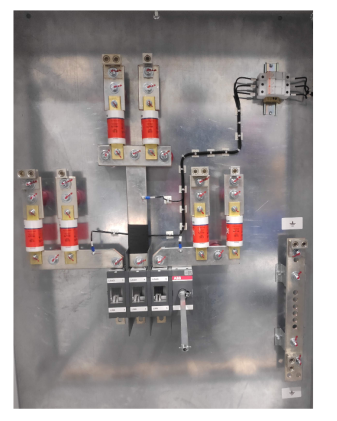Solar panels are becoming a common feature in many buildings. People are gradually turning to renewable energy resources, and solar panels are a cost-effective solution. This increased the demand for solar combiner boxes and installation services.
While the process is simple enough, it is important to determine the right method to string the solar panels and join them to the solar combiner box. The decision depends on the voltage and current you want to generate and supply to the control panel.
- Voltage is the measure of electric current/pressure that flows between two points. Household circuits have standard voltages, such as 110-120V, 220-240V, and 400-440V, to supply power to different appliances.
- Current is the transfer of electrons or electric charge from one point to another per unit of time.
- Electric power is when voltage and current are multiplied by each other. It is measured in watts.
Two Ways to String Solar Panels: Series vs. Parallel
1. Series Stringing of Solar Panel
Series stringing is when the positive terminal of one solar panel is connected to the negative terminal of the following panel and so on. This leads to a series of solar panels where the voltage increases with the addition of each panel but the amperage remains the same throughout. Series stringing is used when you want the solar combiner box to supply a fixed amount of voltage to the electric appliances/inverter.
Also Read: Qualities of a Reliable Solar Combiner Box
2. Parallel Stringing of Solar Panel
Parallel stringing is when the positive terminal of the solar panel is connected to the positive terminal of the next one, and the negative terminal is connected to the negative terminal. This results in a fixed voltage but increases the amperage of the circuit. This connection is used when you need to power inverters with fixed/limited amperage.
Read More: Solar Panel Wiring Basics: An Intro to How to String Solar Panels
Solution Control System designs customized solar combiner boxes confirming the UL1741 standard. Our combiner boxes provide protection and monitor the solar panels to ensure a continuous supply of current. We serve residential, commercial and industrial clients with varying requirements.
How To String Solar Panels?
Stringing solar panels involves connecting them in series or parallel to achieve the desired voltage and current. In a series connection, link the positive terminal of one panel to the negative of the next to increase voltage. For a parallel connection, connect all positives together and all negatives together to maintain voltage while increasing current. Ensure proper wire sizing, use combiner boxes if needed, and follow inverter specifications for efficiency.
Series Stringing of Solar Panels: How It Works & When to Use It
Series stringing of solar panels connects the positive terminal of one panel to the negative of the next, increasing the system voltage while keeping the current the same. This setup is ideal for high-voltage inverters and long cable runs, reducing power loss. Use it when matching inverter voltage requirements or in shaded areas where bypass diodes help maintain performance despite partial obstructions.
Parallel Stringing of Solar Panels: Benefits & Applications
Parallel stringing of solar panels connects all positive terminals together and all negative terminals together, maintaining the same voltage while increasing current. This setup is ideal for low-voltage systems and off-grid applications with battery storage. It improves reliability, as shading on one panel doesn’t significantly impact others. Use parallel connections when working with charge controllers or in systems requiring higher current output.
Series vs. Parallel Solar Panel Connection: Key Differences
Series and parallel solar panel connections differ in voltage and current distribution. Series connections increase voltage while keeping current constant, making them ideal for high-voltage inverters and long-distance transmission. Parallel connections maintain voltage but increase current, suitable for low-voltage systems and battery storage. Series setups are more efficient in high-sun conditions, while parallel setups perform better in partial shading.
How can we boost the efficiency of the Solar Panel?
Boosting solar panel efficiency involves optimizing panel placement, keeping surfaces clean, and using high-quality components. Position panels at the optimal tilt and angle for maximum sunlight exposure. Regular maintenance prevents dirt and debris from reducing output. Using MPPT charge controllers, efficient inverters, and cooling mechanisms also enhances performance. Additionally, reducing shading and using bifacial panels can further improve energy generation.
Choosing the Right Stringing Method for Your Solar Panels
Choosing the right stringing method depends on your system’s voltage, current, and shading conditions. Series stringing increases voltage, making it ideal for grid-tied systems with high-voltage inverters. Parallel stringing increases current, best for low-voltage battery storage and off-grid setups. Consider inverter specifications, wiring efficiency, and shading impact to optimize energy production and ensure reliable system performance.
Conclusion
Selecting the right stringing method is crucial for maximizing solar panel efficiency and meeting system requirements. Whether using series for higher voltage or parallel for increased current, proper planning ensures optimal performance. Regular maintenance, high-quality components, and strategic placement further enhance efficiency. By understanding these factors, you can design a reliable solar energy system tailored to your needs, ensuring long-term sustainability and energy savings.

